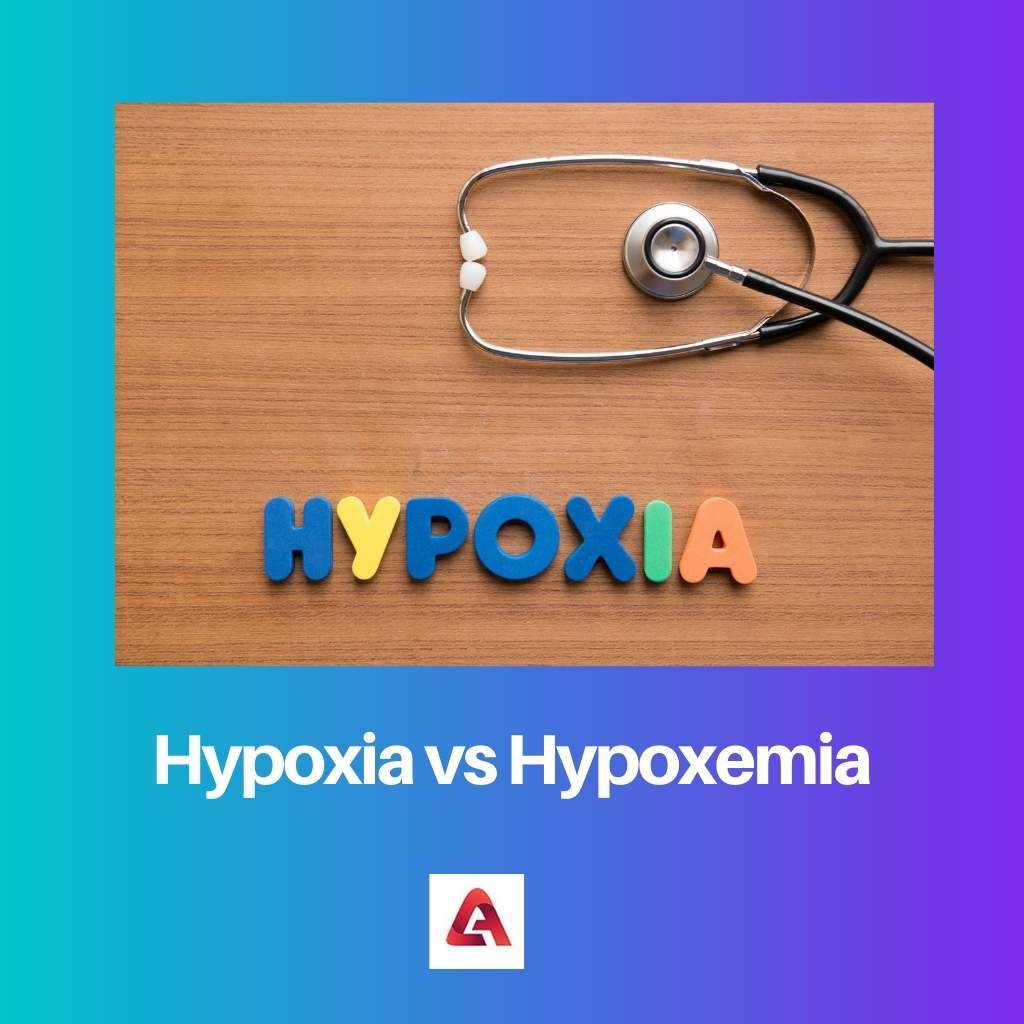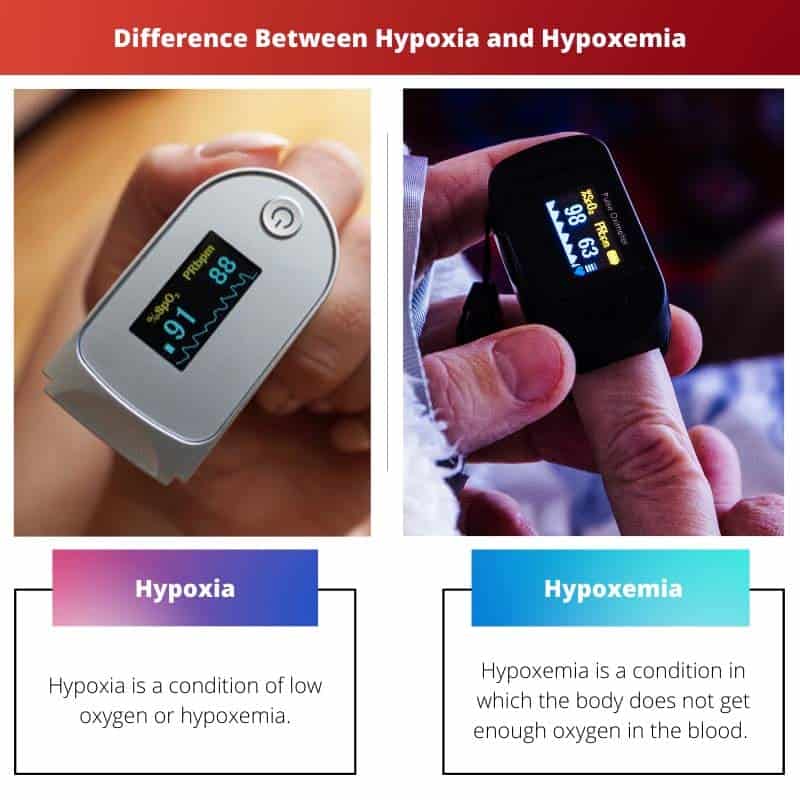Hypoxia and hypoxemia are two terms that sound similar but have very different meanings.
Hypoxia refers to a reduction in tissue oxygenation, whereas hypoxemia is the arterial partial pressure of oxygen (PaO2) which reflects the amount of oxygen dissolved in arterial blood.
Cells that are rich in energy-producing mitochondria are particularly sensitive to low levels of oxygen.
Key Takeaways
- Hypoxia is when the body’s tissues don’t receive enough oxygen, whereas hypoxemia refers to low oxygen levels in the blood.
- Hypoxia can result from hypoxemia, but it can also occur due to issues in oxygen utilization, while hypoxemia primarily results from respiratory problems.
- Treatment for hypoxia focuses on improving oxygen delivery to tissues, while hypoxemia treatment aims to increase blood oxygen levels.
Hypoxia vs Hypoxemia
Hypoxia is a medical condition characterized by the reduction in tissue oxygenation or low levels of oxygen in the blood. Hypoxemia is a severe health condition caused when the arterial partial pressure of oxygen gets dissolved in arterial blood. In hypoxemia, there is not enough oxygen in the blood.

Hypoxia is a condition of low oxygen or hypoxemia. This can be due to a reduction in the partial pressure of oxygen, an insufficient supply of oxygen, or both.
Hypoxia may result from high altitude, poor air quality, pulmonary disease, or heart failure. Hypoxia can also be induced by some forms of training that are used for endurance sports and military applications.
Hypoxemia is a condition in which the body does not get enough oxygen in the blood. It can occur for several reasons, ranging from heart failure to pneumonia.
The most common cause of severe hypoxemia is an impairment in breathing.
Comparison Table
| Parameters of Comparison | Hypoxia | Hypoxemia |
|---|---|---|
| Headache | Normal | Severe |
| Stage | Advanced | Initial |
| Treatment | Medical Evacuation | Lie on the ground |
| Measured | Never | Yes |
| Lack of oxygen | Tissues | Blood |
| Reason | Environmental conditions | Body conditions |
What is Hypoxia?
Hypoxia, or low oxygen levels in the blood, is a common problem affecting millions of people yearly.
The causes are vast and vary from person to person, but some of the most common causes include obesity, smoking, high altitudes, heart disease, and lung disease.
Hypoxia can be debilitating for some people—even fatal for others. For those living with chronic hypoxia, there are several methods available to help decrease their symptoms.
These treatments range from lifestyle changes like losing weight to more invasive procedures. Also included are treatments not yet deemed fully effective despite promising results.
The term “hypoxic” describes environments with low levels of oxygen (O²), whereas ‘anemic’ refers to a reduced concentration of circulating blood cells.
Hypoxia is a condition that occurs when an organism is deprived of adequate amounts of oxygen supply to bodily tissues.
Hypoxia may be classified as either regional (deprivation of oxygen in a specific part of the body) or general (the entire body’s deprivation of oxygen).
Hypoxia is a condition that occurs when the concentration of oxygen in the blood drops below normal levels.
The most common cause of hypoxia is altitude sickness, but pulmonary and cardiac diseases, lung injury, and heart oxygen supply problems can also cause it.
What is Hypoxemia?
Anxiety and panic attacks are among the most frequent causes of severe hypoxemia.
It’s estimated that 60% of people who experience anxiety attacks will have at least one episode where they experience breathing problems.
Those whose anxiety has gone on for a long time or been particularly bad are also more likely to.
Hypoxemia is a condition when the amount of oxygen lowers in the blood content of the body.
Hypoxic conditions can occur in the body when there is not enough oxygen for it to function properly or when the body fails to transport available oxygen to its tissues.
This condition occurs when the cells within your body are unable to obtain sufficient amounts of oxygen.
This lack of oxygen results in damaging effects on your organs, tissues, and cells. Hypoxemia is a condition in which an individual has abnormally low levels of oxygen in the blood.
Hypoxemia can result from several different conditions, including heart failure, COPD, pulmonary embolism, pneumonia, and emphysema.
It can also occur as a result of anything that reduces blood flow to the lungs, such as anemia or certain medications.
Normal levels of oxygen are between 94% and 100%. In hypoxic conditions, there is less than 90% of normal oxygen present. Normal blood gas levels are arterial with venous being.
Main Differences Between Hypoxia and Hypoxemia
- Hypoxia patients may experience headaches, but Hypoxemia patients have severe headaches.
- Hypoxemia is the beginning stage of Hypoxia.
- Hypoxia patients have to undergo medical evacuation, but Hypoxemia patients have to lie on the ground for proper oxygen circulation in their bodies.
- Hypoxia can never be measured, but Hypoxemia can be measured.
- Hypoxia is a lack of oxygen in tissues, but Hypoxemia is a lack of oxygen in the blood.
- Hypoxia happens due to environmental conditions, but Hypoxemia happens due to in-body conditions.





